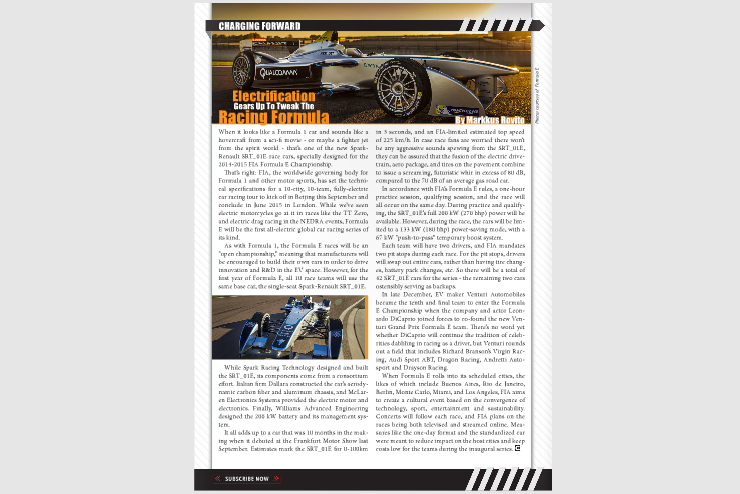When it looks like a Formula 1 car and sounds like a hovercraft from a sci-fi movie – or maybe a fighter jet from the spirit world – that’s one of the new Spark-Renault SRT_01E race cars, specially designed for the 2014-2015 FIA Formula E Championship.
That’s right: FIA, the worldwide governing body for Formula 1 and other motor sports, has set the technical specifications for a 10-city, 10-team, fully-electric car racing tour to kick off in Beijing this September and conclude in June 2015 in London. While we’ve seen electric motorcycles go at it in races like the TT Zero, and electric drag racing in the NEDRA events, Formula E will be the first all-electric global car racing series of its kind.
As with Formula 1, the Formula E races will be an “open championship,” meaning that manufacturers will be encouraged to build their own cars in order to drive innovation and R&D in the EV space. However, for the first year of Formula E, all 10 race teams will use the same base car, the single-seat Spark-Renault SRT_01E.

While Spark Racing Technology designed and built the SRT_01E, its components come from a consortium effort. Italian firm Dallara constructed the car’s aerodynamic carbon fiber and aluminum chassis, and McLaren Electronics Systems provided the electric motor and electronics. Finally, Williams Advanced Engineering designed the 200 kW battery and its management system.
It all adds up to a car that was 10 months in the making when it debuted at the Frankfurt Motor Show last September. Estimates mark the SRT_01E for 0-100km in 3 seconds, and an FIA-limited estimated top speed of 225 km/h. In case race fans are worried there won’t be any aggressive sounds spewing from the SRT_01E, they can be assured that the fusion of the electric drivetrain, aero package, and tires on the pavement combine to issue a screaming, futuristic whir in excess of 80 dB, compared to the 70 dB of an average gas road car.
In accordance with FIA’s Formula E rules, a one-hour practice session, qualifying session, and the race will all occur on the same day. During practice and qualifying, the SRT_01E’s full 200 kW (270 bhp) power will be available. However, during the race, the cars will be limited to a 133 kW (180 bhp) power-saving mode, with a 67 kW “push-to-pass” temporary boost system.
Each team will have two drivers, and FIA mandates two pit stops during each race. For the pit stops, drivers will swap out entire cars, rather than having tire changes, battery pack changes, etc. So there will be a total of 42 SRT_01E cars for the series – the remaining two cars ostensibly serving as backups.

In late December, EV maker Venturi Automobiles became the tenth and final team to enter the Formula E Championship when the company and actor Leonardo DiCaprio joined forces to co-found the new Venturi Grand Prix Formula E team. There’s no word yet whether DiCaprio will continue the tradition of celebrities dabbling in racing as a driver, but Venturi rounds out a field that includes Richard Branson’s Virgin Racing, Audi Sport ABT, Dragon Racing, Andretti Autosport and Drayson Racing.
When Formula E rolls into its scheduled cities, the likes of which include Buenos Aires, Rio de Janeiro, Berlin, Monte Carlo, Miami, and Los Angeles, FIA aims to create a cultural event based on the convergence of technology, sport, entertainment and sustainability. Concerts will follow each race, and FIA plans on the races being both televised and streamed online. Measures like the one-day format and the standardized car were meant to reduce impact on the host cities and keep costs low for the teams during the inaugural series.
This article originally appeared in Charged Issue 11 – DEC 2013



















































































